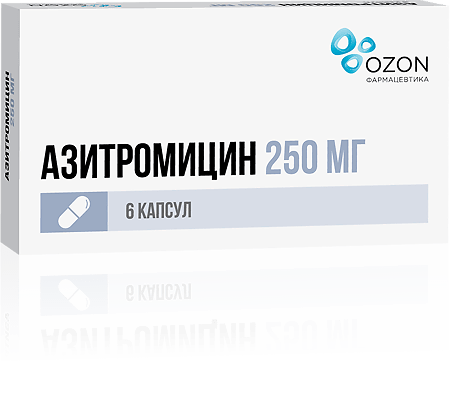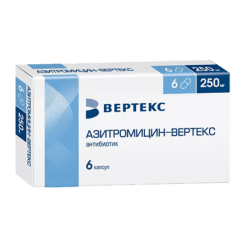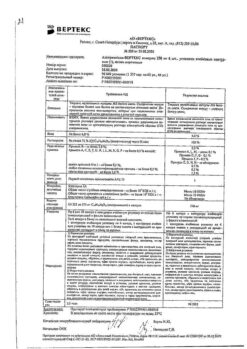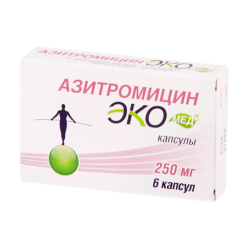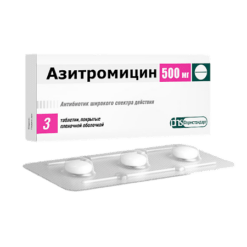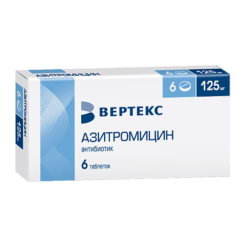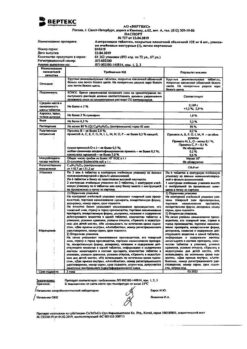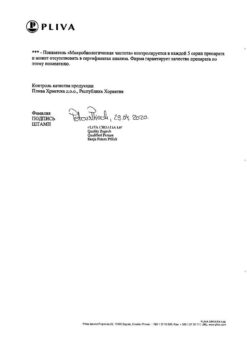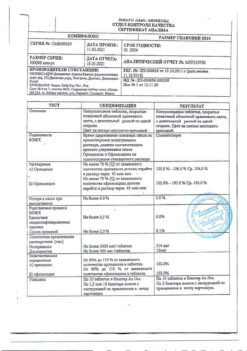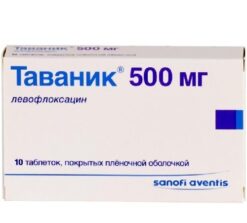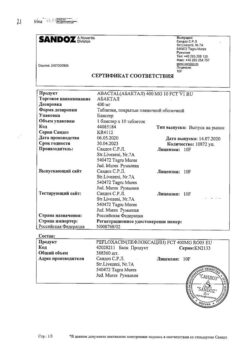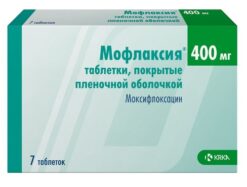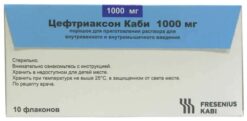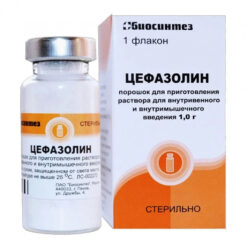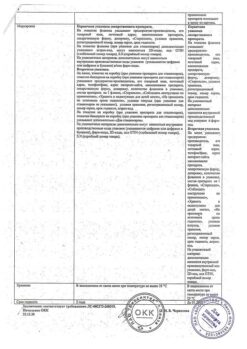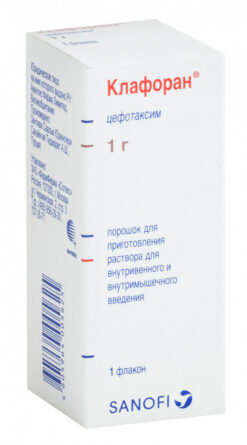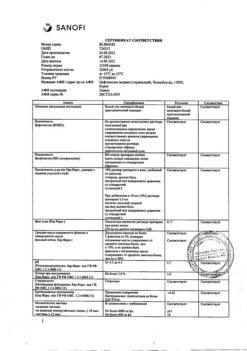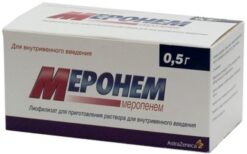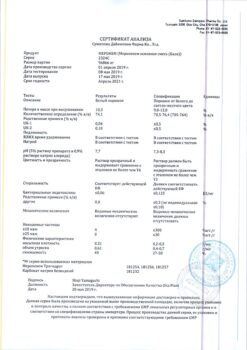No products in the cart.
Azithromycin, 250 mg capsules 6 pcs
€3.93 €3.49
Description
Skin infections, Bronchitis, Tonsillitis, Angina, Gonorrhoea, Infectious diseases, Urethritis, Otitis, Pneumonia, Respiratory tract infections, Pharyngitis
Indications
Indications
Infectious and inflammatory diseases caused by microorganisms sensitive to azithromycin: infections of the upper respiratory tract and ENT organs (sinusitis, tonsillitis, pharyngitis, otitis media); infections of the lower respiratory tract (acute bronchitis, exacerbation of chronic bronchitis, pneumonia, including those caused by atypical pathogens); infections of the skin and soft tissues (acne vulgaris of moderate severity, erysipelas, impetigo, secondary infected dermatoses); uncomplicated urinary tract infections caused by Chlamydia trachomatis (urethritis and/or cervicitis); the initial stage of Lyme disease (borreliosis) is erythema migrans.
Pharmacological effect
Pharmacological effect
Pharmacotherapeutic group: Systemic antibacterial agents; macrolides, lincosamines and streptogramins; macrolides
Pharmacological action
An antibiotic of the macrolide group, a representative of the azalides. Has a wide spectrum of antimicrobial action. The mechanism of action of azithromycin is associated with the suppression of protein synthesis in microbial cells. By binding to the 50S ribosomal subunit, it inhibits peptide translocase at the translation stage, suppresses protein synthesis, and slows down the growth and reproduction of bacteria. In high concentrations it has a bactericidal effect.
It is active against a number of gram-positive, gram-negative, anaerobic, intracellular and other microorganisms.
Gram-positive cocci are sensitive to azithromycin: Streptococcus pneumoniae (penicillin-sensitive strains), Streptococcus pyogenes, Staphylococcus aureus (methicillin-sensitive strains); aerobic gram-negative bacteria: Haemophilus influenzae, Haemophilus parainfluenzae, Legionella pneumophila, Moraxella catarrhalis, Pasteurella multocida, Neisseria gonorrhoeae; some anaerobic microorganisms: Clostridium perfringens, Fusobacterium spp., Prevotella spp., Porphyriomonas spp.; as well as Chlamydia trachomatis, Chlamydia pneumoniae, Chlamydia psittaci, Mycoplasma pneumoniae, Mycoplasma hominis, Borrelia burgdorferi.
Microorganisms with acquired resistance to azithromycin: aerobic gram-positive microorganisms – Streptococcus pneumoniae (penicillin-resistant strains and strains with intermediate sensitivity to penicillin).
Microorganisms with natural resistance: aerobic gram-positive microorganisms – Enterococcus faecalis, Staphylococcus aureus, Staphylococcus epidermidis (methicillin-resistant strains), anaerobic microorganisms – Bacteroides fragilis.
Cases of cross-resistance between Streptococcus pneumoniae, Streptococcus pyogenes (group A beta-hemolytic streptococcus), Enterococcus faecalis and Staphylococcus aureus (methicillin-resistant strains) to erythromycin, azithromycin, other macrolides and lincosamides have been described.
Pharmacokinetics
After oral administration, azithromycin is well absorbed and quickly distributed in the body. After a single dose of 500 mg, bioavailability is 37% due to the “first pass” effect through the liver. Cmax in blood plasma is reached after 2-3 hours and is 0.4 mg/l.
Protein binding is inversely proportional to plasma concentration and ranges from 7-50%. The apparent Vd is 31.1 l/kg. Penetrates through cell membranes (effective against infections caused by intracellular pathogens). Transported by phagocytes to the site of infection, where it is released in the presence of bacteria. Easily penetrates histohematic barriers and enters tissues. The concentration in tissues and cells is 10-50 times higher than in plasma, and at the site of infection it is 24-34% higher than in healthy tissues.
Azithromycin is metabolized in the liver. Metabolites do not have antimicrobial activity.
T1/2 is very long – 35-50 hours. T1/2 from fabrics is much longer. The therapeutic concentration of azithromycin lasts up to 5-7 days after taking the last dose. Azithromycin is excreted mainly unchanged – 50% through the intestines, 6% by the kidneys.
Special instructions
Special instructions
Use with caution in patients with mild to moderate liver dysfunction due to the possibility of developing fulminant hepatitis and severe liver failure. If there are symptoms of liver dysfunction, such as rapidly increasing asthenia, jaundice, dark urine, bleeding tendency, hepatic encephalopathy, azithromycin therapy should be discontinued and a study of the functional state of the liver should be performed.
As with the use of other antibacterial drugs, during therapy with azithromycin, patients should be regularly examined for the presence of non-susceptible microorganisms and signs of the development of superinfections, incl. fungal.
Azithromycin should not be used for longer courses than indicated in the instructions, because The pharmacokinetic properties of azithromycin allow us to recommend a short and simple dosage regimen.
With long-term use of azithromycin, the development of pseudomembranous colitis caused by Clostridium difficile, both in the form of mild diarrhea and severe colitis, is possible. If antibiotic-associated diarrhea develops during the use of azithromycin, as well as 2 months after the end of therapy, pseudomembranous colitis caused by Clostridium difficile should be excluded. Drugs that inhibit intestinal motility are contraindicated.
When treated with macrolides, incl. azithromycin, prolongation of cardiac repolarization and QT interval was observed, increasing the risk of developing cardiac arrhythmias, incl. arrhythmias of the “pirouette” type.
The use of azithromycin may provoke the development of myasthenic syndrome or cause exacerbation of myasthenia gravis.
Isolated cases of serious allergic reactions have been reported, including angioedema and anaphylaxis (rarely fatal), dermatological reactions, including acute generalized exanthematous pustulosis, Stevens-Johnson syndrome, toxic epidermal necrolysis, erythema multiforme, drug rash with eosinophilia and systemic manifestations (DRESS syndrome). Some of the reactions were recurrent and required longer observation and treatment.
Impact on the ability to drive vehicles and machinery
If undesirable effects on the nervous system and organ of vision develop, patients should be careful when performing actions that require increased concentration and speed of psychomotor reactions.
Active ingredient
Active ingredient
Azithromycin
Composition
Composition
Active ingredient: azithromycin
Pregnancy
Pregnancy
Use during pregnancy is possible only in cases where the expected benefit to the mother outweighs the potential risk to the fetus. If it is necessary to use azithromycin during lactation, the issue of stopping breastfeeding should be decided.
Contraindications
Contraindications
Hypersensitivity to azithromycin, erythromycin, other macrolides or ketolides; severe liver dysfunction; simultaneous use with ergotamine and dihydroergotamine; children up to 6 months of age (for the dosage form, powder for the preparation of a suspension); children under 3 years of age (for the 125 mg tablet dosage form), children under 12 years of age with a body weight of less than 45 kg (for the 500 mg tablet dosage form).
With caution: myasthenia gravis; mild to moderate liver dysfunction; end-stage renal failure with GFR less than 10 ml/min; patients with the presence of proarrhythmogenic factors (especially in old age) – with congenital or acquired prolongation of the QT interval, patients receiving therapy with antiarrhythmic drugs of classes IA (quinidine, procainamide) and III (dofetilide, amiodarone and sotalol), cisapride, terfenadine, antipsychotic drugs (pimozide), antidepressants (citalopram), fluoroquinolones (moxifloxacin and levofloxacin), with disturbances in water and electrolyte balance, especially with hypokalemia or hypomagnesemia, with clinically significant bradycardia, arrhythmia or severe heart failure; simultaneous use of digoxin, warfarin, cyclosporine.
Side Effects
Side Effects
From the hematopoietic system: infrequently – leukopenia, neutropenia, eosinophilia; very rarely – thrombocytopenia, hemolytic anemia.
Allergic reactions: rarely – skin rash, angioedema and anaphylaxis (in rare cases fatal), erythema multiforme, drug rash with eosinophilia and systemic manifestations (DRESS syndrome). Some of these reactions that developed with the use of azithromycin became recurrent and required long-term treatment and observation.
From the skin and subcutaneous tissues: infrequently – skin rash, itching, urticaria, dermatitis, dry skin, sweating; rarely – photosensitivity reaction; frequency unknown – Stevens-Johnson syndrome, toxic epidermal necrolysis, erythema multiforme.
From the nervous system: often – headache; infrequently – dizziness, disturbance of taste, paresthesia, drowsiness, insomnia, nervousness; rarely – agitation; frequency unknown – hypoesthesia, anxiety, aggression, fainting, convulsions, psychomotor hyperactivity, loss of smell, perversion of smell, loss of taste, myasthenia gravis, delirium, hallucinations.
On the part of the organ of vision: infrequently – visual impairment.
From the organ of hearing and labyrinthine disorders: infrequently – hearing loss, vertigo; frequency unknown – hearing impairment up to deafness and/or tinnitus.
From the cardiovascular system: infrequently – palpitations, flushing of the face; frequency unknown – decreased blood pressure, increased QT interval on ECG, pirouette-type arrhythmia, ventricular tachycardia.
From the respiratory system: infrequently – shortness of breath, nosebleeds.
From the digestive system: very often – diarrhea; often – nausea, vomiting, abdominal pain; uncommon – flatulence, dyspepsia, constipation, gastritis, dysphagia, bloating, dry oral mucosa, belching, ulcers of the oral mucosa, increased secretion of the salivary glands; very rarely – change in tongue color, pancreatitis.
From the liver and biliary tract: infrequently – hepatitis; rarely – impaired liver function, cholestatic jaundice; frequency unknown – liver failure (in rare cases with death, mainly due to severe liver dysfunction), liver necrosis, fulminant hepatitis.
From the musculoskeletal system: uncommon – osteoarthritis, myalgia, back pain, neck pain; frequency unknown – arthralgia.
From the kidneys and urinary tract: infrequently – dysuria, pain in the kidney area; frequency unknown – interstitial nephritis, acute renal failure.
From the reproductive system: infrequently – metrorrhagia, dysfunction of the testicles.
Infectious diseases: infrequently – candidiasis (including the mucous membrane of the oral cavity and genitals); frequency unknown – pseudomembranous colitis.
From the laboratory parameters: often – a decrease in the number of lymphocytes, an increase in the number of eosinophils, an increase in the number of basophils, an increase in the number of monocytes, an increase in the number of neutrophils, a decrease in the concentration of bicarbonates in the blood plasma; infrequently – increased activity of AST, ALT, increased concentration of bilirubin in the blood plasma, increased concentration of urea in the blood plasma, increased concentration of creatinine in the blood plasma, change in the potassium content in the blood plasma, increased activity of alkaline phosphatase in the blood plasma, increased chlorine content in the blood plasma, increased concentration of glucose in the blood, increase in the number of platelets, increased hematocrit, increased concentration of bicarbonates in the blood plasma, change in the sodium content in the blood plasma.
Other: infrequently – asthenia, malaise, anorexia, feeling of fatigue, facial swelling, chest pain, fever, peripheral edema.
Interaction
Interaction
Simultaneous use of macrolide antibiotics, incl. azithromycin, with P-glycoprotein substrates such as digoxin, leads to increased serum concentrations of P-glycoprotein substrate. With the simultaneous use of digoxin or digitoxin with azithromycin, a significant increase in the concentration of cardiac glycosides in the blood plasma and the risk of developing glycoside intoxication are possible.
When azithromycin is used simultaneously with warfarin, cases of increased effects of the latter have been described.
Azithromycin weakly interacts with isoenzymes of the cytochrome P450 system.
Given the theoretical possibility of ergotism, simultaneous use of azithromycin with ergot alkaloid derivatives is not recommended.
Concomitant use of atorvastatin (10 mg daily) and azithromycin (500 mg daily) did not cause changes in atorvastatin plasma concentrations (based on an HMC-CoA reductase inhibition assay). However, in the post-marketing period, isolated case reports of rhabdomyolysis have been received in patients receiving concomitant azithromycin and statins.
In pharmacokinetic studies of the effect of a single dose of cimetidine on the pharmacokinetics of azithromycin, no changes in the pharmacokinetics of azithromycin were detected when cimetidine was administered 2 hours before azithromycin.
Potentiation of the anticoagulant effect has been reported after simultaneous use of azithromycin and indirect anticoagulants (coumarin derivatives). The need for frequent monitoring of prothrombin time should be taken into account when using azithromycin in patients receiving indirect oral anticoagulants (coumarin derivatives).
Caution should be exercised when used concomitantly with cyclosporine. If concomitant use is necessary, monitor plasma concentrations of cyclosporine and adjust the dose accordingly.
It has been found that the simultaneous use of terfenadine and macrolides can cause arrhythmia and prolongation of the QT interval.
When used simultaneously with disopyramide, a case of development of ventricular fibrillation has been described.
When used simultaneously with lovastatin, cases of rhabdomyolysis have been described.
When used simultaneously with rifabutin, the risk of developing neutropenia and leukopenia increases.
Manufacturer
Manufacturer
Ozon, Russia
Additional information
| Manufacturer | Ozon, Russia |
|---|---|
| Medication form | capsules |
| Brand | Ozon |
Other forms…
Related products
Buy Azithromycin, 250 mg capsules 6 pcs with delivery to USA, UK, Europe and over 120 other countries.

